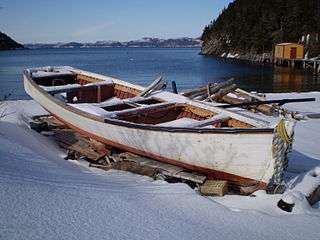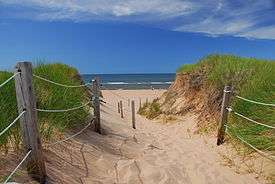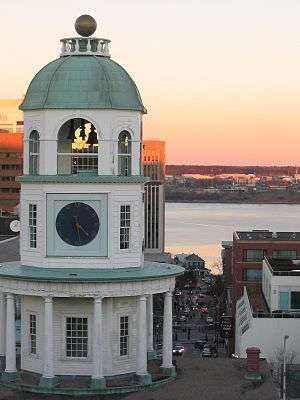Atlantic Canada
Atlantic Canada, also known as the Atlantic Provinces, consists of Newfoundland and Labrador, New Brunswick, Nova Scotia and Prince Edward Island in eastern Canada. While much of the inland consists of forests, and there is a good deal of mining in some areas, fishing has been important to the provinces since the first European settlers arrived.
The term the Maritimes is also used, but it does not include Newfoundland since it originated before 1949 when Newfoundland joined Canada.
Understand

The people of the Atlantic Provinces are historically of west European (Scottish, Irish, English, French) and First Nations heritage. The Mi'kmaq Nation's reserves throughout Nova Scotia, Prince Edward Island and eastern New Brunswick dominate aboriginal culture in the Maritimes region, while Newfoundland and Labrador has a unique history of Innu, Inuit, and Mi'kmaq groups. The first aboriginal group likely to have encountered Europeans in Newfoundland, the Beothuk, have long since disappeared through a combination of European encroachment, disease, and the occasional bloodletting between the two populations.
Despite the region's strong Aboriginal and Acadian cultural heritage, it normally conjures up Celtic images for Canadian tourists, on account of the Scottish and Irish heritage of these provinces. A fragment of Gaelic culture remains in Nova Scotia but primarily on Cape Breton Island, where Gaelic is still a dominant language in some communities.
The term "Atlantic Canada" is still relatively new, having been adopted by Canadian Bureaucrats following Newfoundland's entry into Canada in 1949. As such, there is an important distinction between the Atlantic Provinces, which include all four provinces, and the Maritimes: the Maritimes refer to the three Atlantic provinces of Nova Scotia, New Brunswick, and PEI. Maritimers and Newfoundlanders and Labradorians will be quick to point this out if someone confuses the two, but are quite forgiving regarding this confusion.
Acadia
Acadia (in French Acadie) was the name given by the French to a territory in northeastern North America, including parts of eastern Quebec, the Atlantic Provinces of Canada and modern-day New England stretching as far south as Philadelphia. Later, the territory was divided into the British colonies which were to become American states and Canadian provinces. The Acadians were expelled from the region by the British. Many of these expelled Acadians found their way to Louisiana, becoming known as Cajuns, while others returned to their homeland.
Today, Acadia refers to regions of Atlantic Canada with French roots, language, and culture. In the abstract, Acadia refers to the existence of a French culture on Canada’s east coast. In 2004, Canada celebrated 400 years of Acadia (and it also celebrated 500 years of the French presence on the island of Newfoundland).
Music
The Atlantic region is famous for its traditional music, heavily influenced by the folk traditions of Western Europe, but with a distinctive local twist. Music is one of the main carriers of local ethnic cultures here, and it is possible to hear both French and Scots Gaelic songs sung, on Cape Breton Island for example, despite the overwhelming use of English in daily life.
Although Celtic influences are seen throughout the region, Newfoundland's music is distinct, incorporating much of the traditions of Irish and British sailors' and fishermen's sea shanties. Newfoundland's traditional music industry is at least as strong as that of Ireland, and groups like Great Big Sea have found mainstream success on "the mainland" (Canada).
Provinces

| Newfoundland and Labrador The northernmost and most sparsely populated of the Atlantic provinces. |
| New Brunswick Canada's only officially bilingual province. |
| Nova Scotia A peninsula in the Atlantic. |
| Prince Edward Island One of the first provinces to be settled by Europeans, still the smallest by land area and population. |
Cities
While Atlantic Canada has been mostly a rural place steeped in natural resource economies, it is home to a number of historic cities that are central to the cultural life of the region.
- 🌍 Halifax -- the largest city in the Atlantic Provinces, a historic port city that serves as the region's economic centre on the eastern coast of Nova Scotia.
- 🌍 Sydney -- the most populated city in Cape Breton Island, a part of Nova Scotia.
- 🌍 Saint John -- the oldest incorporated city in Canada, as well as the second-largest city in New Brunswick.
- 🌍 Moncton -- New Brunswick's largest city and the only officially bilingual city in Canada, notable for its Franglais dialect and Acadian history (it was a centre in New Brunswick for Acadian Deportation by the British).
- 🌍 Fredericton is the capital city of New Brunswick. It is situated on the St. John River and is a very clean and beautiful city.
- 🌍 Charlottetown -- the capital city of Prince Edward Island and the city where the Confederation of Canada was negotiated. The area also has Acadian history across the harbour in the settlement on Port La Joye.
- 🌍 St. John's -- one of the oldest cities in North America and the historic capital of the New World on the island of Newfoundland.
Other destinations

Atlantic Canada is full of interesting places found outside of its urban centers. Check out:
- 🌍 Bay of Fundy — separating New Brunswick and Nova Scotia, boasts the World's highest tides
- 🌍 Gros Morne National Park — UNESCO World Heritage Site, north of Corner Brook, Newfoundland and Labrador
- 🌍 L'Anse aux Meadows National Historic Site — Site of an ancient Viking settlement, the earliest European settlement in North America, dating from 1000 A.D., in the Northern Peninsula of Newfoundland and Labrador
- 🌍 Peggy's Cove — a scenic and historic Nova Scotia fishing community with picturesque ocean views and the world's most photographed lighthouse. Look for the metallic plaques melded into the rocks warning all who walk on the rocks that danger is imminent from crashing waves. The lighthouse includes a famous post office which operates during the summer months. Send a postcard from here to get your special postal mark. There is a souvenir shop near the lighthouse for the usual run-of-the-mill mementos. The township of Peggy's Cove is a delight for photographers - even amateurs will have an easy time taking poster-worthy pictures.
- 🌍 Saint John River Valley — historic wooden covered bridges, river ferries, falls, as well as artist studios and historic sites
- 🌍 Kejimkujik National Park — petroglyphs, canoeing, sandy beaches, and many species of birds
- 🌍 Prince Edward Island National Park — covers much of the central north coast around Cavendish and Rustico Harbour, including "Green Gables" and other sites related to the Anne of Green Gables books and their author, Lucy Maud Montgomery
Talk
While the people of the Atlantic Provinces predominantly speak English and French, there are regional dialects of these languages that can throw off the average Central Canadian tourist, not to mention those from abroad.
Some rural communities in the Maritime Provinces have unique vernacular expressions unfamiliar to tourists. For example, "some fine" means "very good". Such expressions will not hamper a tourist's understanding of locals, but it may be a noticeable feature in certain areas. Not limited to Atlantic Canada, some of these expressions can be found in neighbouring US states.
Acadian French
Acadian French (le français acadien) is a dialect of French spoken by the Acadians in the Canadian Maritimes provinces. Like other Canadian French dialects, it diverged from the French of France about 400 years ago at the time of the French colonization of the Americas, and sounds different to visiting Francophones. Acadians and francophones from Quebec can understand each other with little difficulty.
Newfoundland English, French, and Irish
In Newfoundland, another dialect of English is found in combination with any number of local variations. It is often noted that a Newfoundlander can give away his or her home town simply by speaking. In some areas, an Irish lilt can be heard, while in other areas it may not be present.
A few Newfoundland English expressions you may encounter:
- Where you to?: Where are you? (also used to ask 'How are you?')
- Stay where you're to.: Don't leave.
- Stay where you're to 'til I comes where you're at.: Wait there for me.
- Flat on the back with that!: An expression of approval, male speaker
- Flat on the back for that!: An expression of approval, female speaker
- b'y (pronounced bye): boy, guy, man, friend (sometimes used in a general way to include males and females)
Though Newfoundland English is alive and well, Newfoundland Irish is extinct and Newfoundland French very nearly so. Newfoundland Irish was a dialect of the Irish language specific to the island of Newfoundland and was widely spoken until the mid-20th century. It was very similar to the accent heard in the southeast of Ireland, due to mass immigration from the counties Tipperary, Waterford, Wexford and Cork. Newfoundland is the only place outside Europe with its own distinctive name in the Irish language, Talamh an Éisc, literally "Land of Fish". Newfoundland French is distinct from other Canadian dialects including Quebec French and Acadian French and was deliberately discouraged by the government through the 20th century; today it holds on for dear life with a few hundred speakers clustered in the Port au Port Peninsula.
Get in
By plane
Halifax has the main international airport in the region. Flights can also be made to Sydney in Cape Breton from Halifax, or periodically from Boston, Toronto, or other Maritime cities.
- Halifax International Airport
- St. John's International Airport
- Greater Fredericton Airport
- Greater Moncton International Airport
- Saint John Airport
- Charlottetown International Airport
By bus
- Greyhound connects to the Atlantic Provinces, and in some cases their passes include coach services in the Maritimes.
- DRL Coachlines Ltd. offers daily scheduled passenger coach services in Newfoundland. DRL's head office is in Dartmouth, Nova Scotia, but they can be reached toll-free at +1-888-738-8091.
- Maritime Bus offers bus transport throughout the Maritime Provinces.
By ferry
Ferry service is available from Prince Edward Island to Pictou, Nova Scotia, or Newfoundland to North Sydney, Nova Scotia.
Get around
- PEI Express Shuttle offers service between PEI and Halifax. Three days advance reservation is recommended.
See

- Historical recreations at the Halifax Citadel or Fortress Louisbourg
- World's highest tides at Fundy National Park on the Bay of Fundy
- Anne of Green Gables' house at Prince Edward Island National Park on PEI
- Alexander Graham Bell's house at Baddeck, Nova Scotia
- A coal mine under the ocean floor at Sydney, Nova Scotia
- The Viking archeological site of L'anse Aux Meadows, NL
- The iconic Hopewell Rocks outside of Moncton, NB
Do
- Eat a "church basement lobster supper" in PEI
- Join the "Order of Good Cheer" in Annapolis Royal, NS
- Golf the historic course at St. Andrews, NB
- Watch a production of Anne of Green Gables in Charlottetown, PEI
- Go to the Ripley's Believe it or Not Odditorium in Cavendish, PEI
- Go deep-sea cod fishing just about anywhere in the region
- Go whale watching just about anywhere
- Go iceburg hunting off Newfoundland
- Drive the scenic Cabot Trail on Cape Breton Island, NS
- Go fly fishing on the Miramichi River upriver from Miramichi, NB
Eat
The whole region is famous for its seafood. The clam chowder is to die for and the mussels are legendary. Nova Scotia is famous for its scallops and lobsters; PEI for mussels, oysters and lobsters; Newfoundland for "fish" (always refers to cod) and seal-flipper pie (yes, made from flippers of seals). The local cuisine is marked by the origins of the population, French for the Acadians (e.g. scallops severed "coquille St. Jacques"), and British and Irish for the English-speakers (e.g. hodge-podged vegetables).
Drink
When out at a pub enjoying the scene, the usual Canadian mass-market beers are available, but local specialties may be found as well. In Nova Scotia try an Alexander Keith's India Pale Ale and in New Brunswick reach for Moosehead Lager. All four provinces in the region each have several excellent craft breweries: for example, PEI has 5 independent craft breweries from tip-to-tip with a total population of 150,000.
In Newfoundland the drink they try to force on tourists in called "screech". This is a high-proof rum from Jamaica that is the province's unofficial national drink. The drink goes back the days of the British Empire, when sailing ships full of salted codfish from Newfoundland would sail down to Jamaica and return home with a cargo of rum. Be careful when trying this, it is very strong!
Fruit wines are made in all four provinces (e.g., blueberry, strawberry), while Nova Scotia and New Brunswick also make grape wines.
Stay safe
Since most tourist destinations in the region are rural, crime is less of a threat than getting lost. The weather can turn ugly quickly, so be prepared. Moose are a huge member of the deer family (called "elk" in Europe), and are a common hazard on the roads.
Go next
The neighbouring province of Quebec offers an immersion in a unique French-speaking culture, while just to the south there is the charm of the New England region of the United States. Both are accessible by ferry or road.